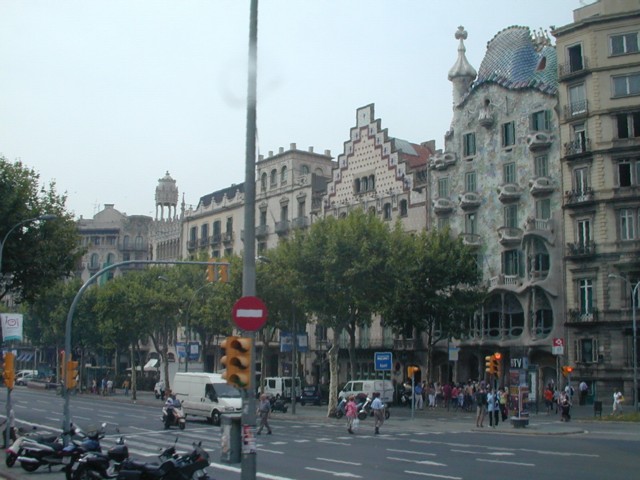

This morning we walked to the Plaça de Catalunya, a focal point of Barcelona, to board the buses for a driving tour around the city. Catalunya is the local name for what we call Catalonia in English, a culturally distinct region of Spain of which Barcelona is the chief city; Catalan, the local language (also the name for the people), is a Romance language with similarities to both Spanish and French. Our local guide noted that "Barcelona's chief exports are architecture and design," and she showed us many distinctive buildings and statues by influential Catalan architects and famous foreign architects and artists (I. M. Pei, Mies van der Rohe, Roy Lichtenstein, ...) who had come to Barcelona to contribute to its heritage. She pointed out these three houses by major Catalan architects, situated on the same block; the nearest one, with the organic-looking curves, is the Casa Batllo by Antoni Gaudi. It is intended to evoke a dragon, with its scales and spines; the balconies looking out like pairs of eyes represent the maidens the dragon has carried off!
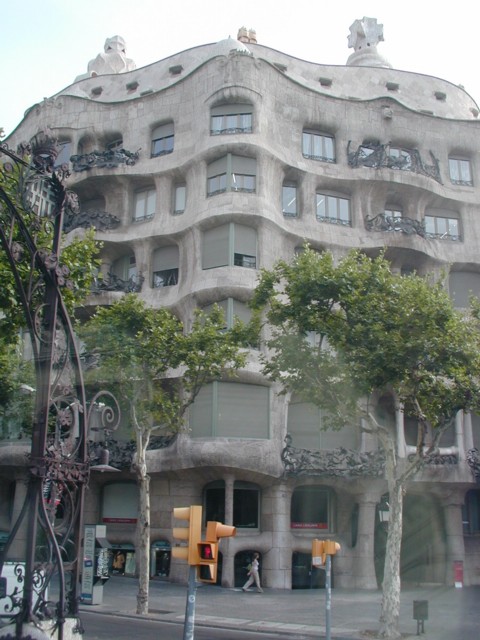
Another of Gaudi's distinctive buildings is the Casa Mila, with chimneys that evoke plumes of smoke. A local nickname for this building is "pedrera," which means "quarry" in Catalan, because of the heavy stone front. Note the ironwork balconies; ironmongery has been an important craft here for several centuries, and we saw many fine examples of local artisans' work. In earlier centuries the ground floor would be used for shops and commerce, with the family who owned the building residing on the next floor up, and servants' quarters above them (so the owner's family didn't have to climb so many stairs!), an arrangement that is reflected in the many older buildings we saw with ornate and spacious balconies on the second floor and much simpler ones above.
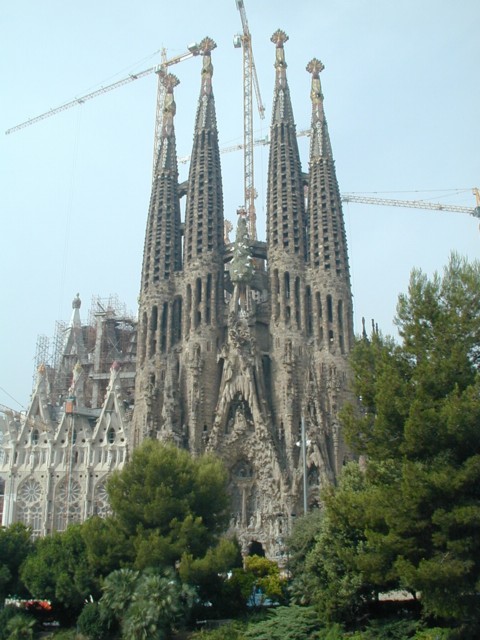
Gaudi's masterpiece, though, is the unfinished Sagrada Familia (Holy Family) church. This was begun in 1882 and the project taken over by Gaudi shortly thereafter; he worked on it until his death in 1926. Gaudi was evidently very difficult to work with; he would sometimes show up at the construction site with design changes scribbled on cigarette rolling papers, causing untold extra work for the craftsmen actually trying to put stone on stone! The plans and models were destroyed in the Spanish Civil War of the late 1930s; some sketches were found in the 1950s, and a decision was made to raise private funds and complete the project. If all goes well, it could be finished in another 25 years...
When construction was halted, eight of the planned eighteen towers (107 meters tall, with the unbuilt central pinnacle rising to 170 meters) and one of the three planned facades had been built. This is the darker stone in the photo above; the newer work is made of the same local materials, but hasn't been exposed to the weather as long. The Nativity facade, depicting scenes from Christ's childhood, was the one that was finished; the cavelike grottoes and the tree rising between the spires (sheltering birds as the church shelters souls) are characteristic of Gaudi's style of "modernisme," in which forms reflect nature as much as possible. On the back is the Passion facade, and yet to be completed at the left of the photo is the Gloria facade. There are buildings just beyond that facade, which will be pulled down when it is finished; the land on which they sit had been set aside for a garden, as was the case in front of the other two facades, but after construction stopped on the church the city leased them for new buildings. There was a proviso that if the church ever was finished, though, the lease would terminate; so let's check back in 25 years.
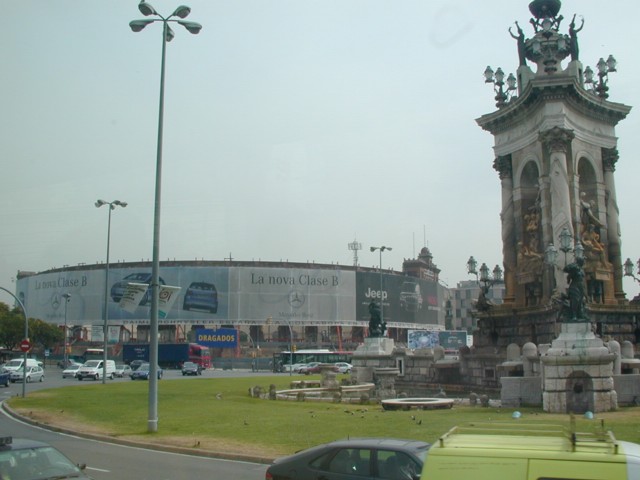
One of the two open-air bullrings in town, seen here beyond a statue celebrating the three seas on which Spain borders, is being converted into a shopping center. I understand the other is still used during the summer months.
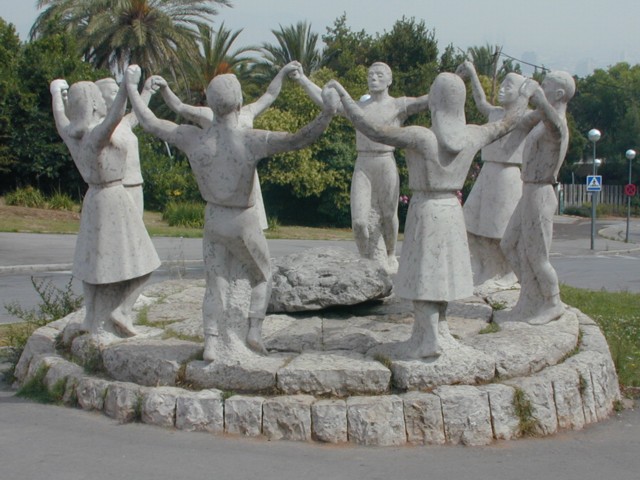
Next we rode in the buses up Montjuïc, the mountain overlooking the city. The name means "Mountain of the Jews"; centuries ago the only cemeteries in town were Catholic, so Jewish residents had to be buried outside the city on this mountain. Unfortunately I don't have any good photos to show of the sports arenas and other buildings created there for the 1992 Barcelona Olympics, or of the botanical gardens or other sights up Montjuïc; the road was just too twisty and switchbacked to get decent angles from the bus! The day was quite hazy, too, so we didn't get a clear view of the city or its busy harbor either. However, when we got out near the top to look around and get a drink (it was muggy!), we found this nice statue of people dancing the sardana. This is a local variant of the circle dance popular around the Mediterranean (for example, the sirtaki of Greece). The stone in the center of the circle represents the burdens people might have laid down to join in a dance they happened upon while heading home with packages; that way they could keep an eye on their stuff while they danced. I guess the pickpocket problem goes back a ways!
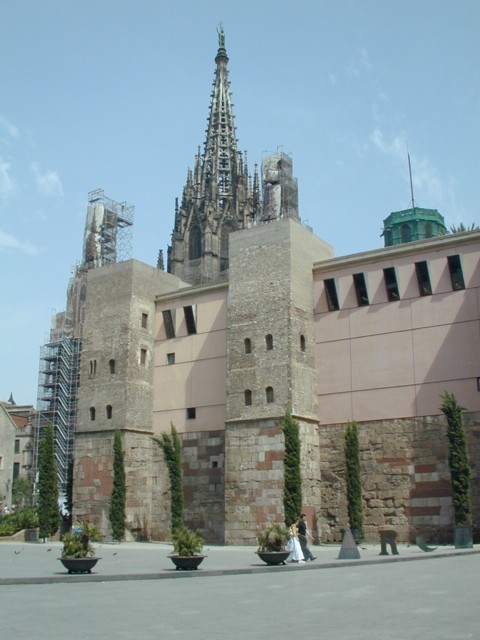
Next we got out of the buses for the day and walked a short distance to the Barcelona Cathedral. The facade was completely covered up for cleaning; here you see the spires rising above some twelfth-century towers built on top of Roman foundations (with some modern superstructure added, as well). The city walls were pulled down in the 1860s to allow the city to build out and relieve overcrowding, and we saw several remnants of the walls with new construction on and around them. The cathedral itself dates to the 13th century, replacing predecessors from the 11th and 7th centuries.
Adjacent to the cathedral is the 12th-century palace of the Count of Barcelona. This noble house married into the royal house of Aragon, and the palace is where Christopher Columbus (Cristobal Colom as he's known in Catalan) was received by the King and Queen upon his return from America.

The cathedral has parts built in the Romanesque style and parts in the Gothic style. There are numerous gargoyles representing exotic creatures, the more exotic the better; this is a close-up of one in the shape of somebody's idea of an elephant based on distant reports of a huge animal on whose back people built seige towers.

All around the tourist-frequented areas we visited, we saw many street performers, from mimes painted as statuary and standing totally still to these dancers. The building in the background depicts a popular local custom at fairs and celebrations, with giant puppets of kings and queens who arrive to be greeted by children waving palm brances; the palm tree is a symbol of welcome in Catalonia, and we saw it represented on the Sagrada Familia church, for example.
Finally, we walked through the city's Gothic Quarter to the Palau de la Musicá Catalana, the Palace of Catalan Music. "Gothic Quarter" means "narrow streets" in every city I've visited, so I could only shoot photos that capture part of the rich decoration of the building, by a contemporary of Gaudi's (and a fellow exponent of "modernisme"), Lluís Domènech i Montaner. This is a UNESCO World Heritage Site; additions at such sites, like the "petit Palau" in the foreground, tend to be done in very different styles so there's no confusion about what's the original building. Fortunately, local materials were used by local craftsmen to build it from 1905 to 1908, so it was possible to repair damage from the Civil War and later to renovate much of the building to match the original; less easy to fix was the German organ, which sat silent for thirty years after succumbing to age in the 1970s, but which has recently been reborn with a modern "fly by wire" console connected to the pipes via fiber-optic cables so that it can be moved out of the auditorium when not needed. We heard it playing Mendelssohn's Sixth Sonata as we walked out, and it sounded like it was in splendid condition!
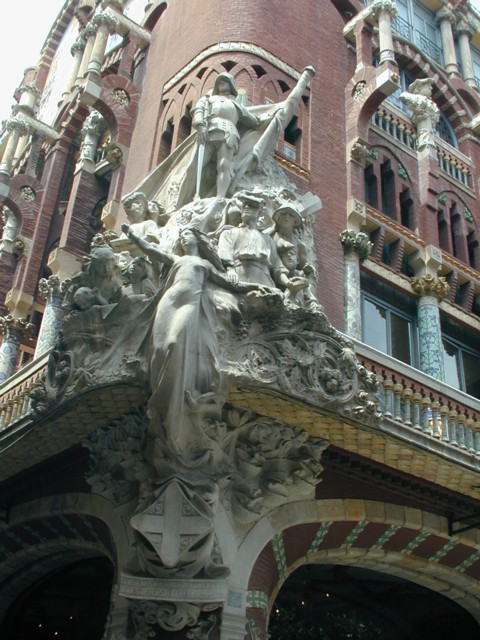
I'm sorry to keep telling you what I was unable to shoot for this website; the interior was even more grand and richly decorated than the outside, but photography was off limits. The main auditorium was decorated with many allegories of different types of music and dance; it seats over two thousand people on several levels, and can see as many as four performances per day! We weren't able to get on the schedule to perform here, but our hosts did invite us to sing as we sat in the rows of seats; we sang "Cantate Domino Canticum Novum": "Sing to the Lord a New Song." This sculpture on the corner of the building gives some idea of the depth of allegory in the interior decorations: the central female figure represents the human voice, and also celebrates the fact that the Orfeó Català, which owns the building, was one of the first local singing groups to admit women, in 1894. The figures around and above her represent a cross-section of Catalan society, showing that the music celebrated here is the music of the people. Above, with his sword, is St. George (San Jordi), who along with Our Lady of Montserrat (where we'll sing tomorrow) is the patron saint of Catalonia.
The recurring floral motifs, in addition to being a signature of the architect, also represent "Roses of May," a popular song composed by the founder of the group that became the Orfeó Català. Spanish (and Catalan) distinguishes between a professional or semiprofessional singing group, an "orfeó" (after the mythical semi-divine singer Orpheus), and a popular "chor" like, say, ourselves. Josep Anselm Clave, the founder, created his "chor" as a means of social uplift for local workingmen, and over time it metamorphosed into the present Orfeó. This is not unlike the origins of the male choral tradition we encountered in Wales on our last tour.
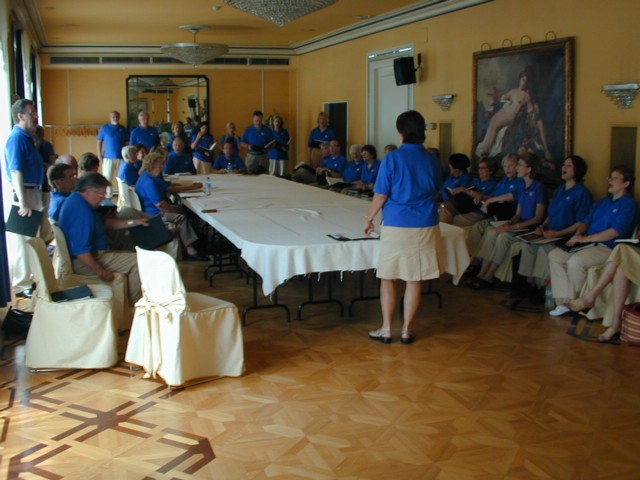
Our tour this morning was arranged so that we'd end up within walking distance of our hotel, so after we left the Palau we had an hour or two to get lunch or rest up, and then we met in a conference room at the hotel to rehearse. We weren't sure if we would have access to the organ at the Barcelona Cathedral, so we warmed up all our a capella songs; then we walked to the cathedral.
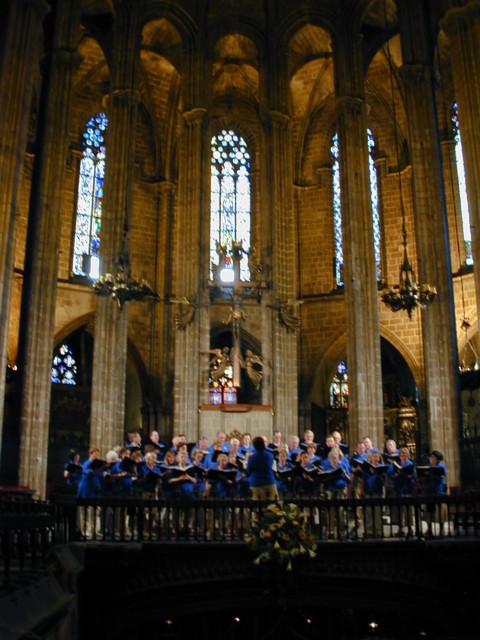
As it happened Lee was able to get up to the organ, so we chose some a capella and some accompanied songs. This photo was shot (with my ol' camera) by Steve Campbell--many thanks! I had forgotten what a thrill it is to sing in a place where your voices can really reverberate. We sang for 45 minutes in front of the main altar, and then Lee played a postlude on the organ. Actually, she had a small glitch that paralleled one that happened on the last tour! At our first concert of that tour, in Christ Church Cathedral, she found that she had forgotten the glasses she usually wears to play the organ, so she did the entire concert wearing her regular glasses upside down! At our first concert of this tour, one of the lenses of her glasses popped out and its retaining screw went missing, so she had to play the whole time using only the other eye. We hope that's the extent of her mishaps for this tour!
One final note, to our friends and family in the Los Angeles area: Pat Johnson picked up a copy of the Sunday Los Angeles Times (I'm not sure where--we were on the road by then!) and found that there was a big article on Barcelona, with photos of many of the places we've seen! It might be worth your while to take a look; at least part of the text of the article is available online too.
 To
Tuesday, 28 June 2005
To
Tuesday, 28 June 2005 Back
to choir tour itinerary
Back
to choir tour itinerary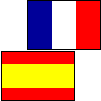 Back
to choir tour home page
Back
to choir tour home pagenew 27 June 2005